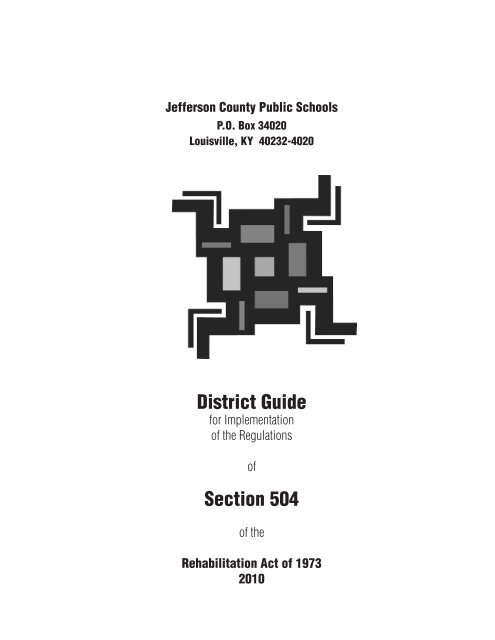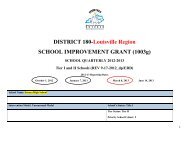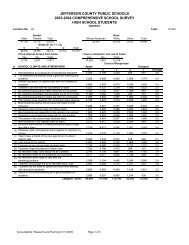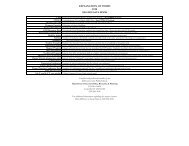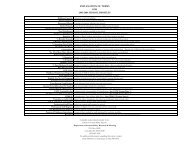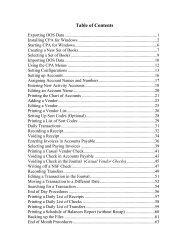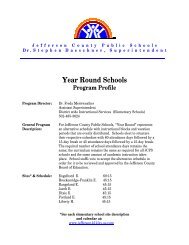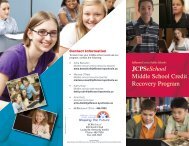District Guide Section 504 - Jefferson County Public Schools
District Guide Section 504 - Jefferson County Public Schools
District Guide Section 504 - Jefferson County Public Schools
You also want an ePaper? Increase the reach of your titles
YUMPU automatically turns print PDFs into web optimized ePapers that Google loves.
<strong>Jefferson</strong> <strong>County</strong> <strong>Public</strong> <strong>Schools</strong><br />
P.O. Box 34020<br />
Louisville, KY 40232-4020<br />
<strong>District</strong> <strong>Guide</strong><br />
for Implementation<br />
of the Regulations<br />
of<br />
<strong>Section</strong> <strong>504</strong><br />
of the<br />
Rehabilitation Act of 1973<br />
2010
Table of Contents<br />
<strong>Section</strong> <strong>504</strong> of the Rehabilitation Act ...........................................................................................................1<br />
Definitions ......................................................................................................................................................1<br />
<strong>Jefferson</strong> <strong>County</strong> <strong>Public</strong> School <strong>District</strong> Obligations<br />
for Elementary and Secondary Education .....................................................................................................5<br />
Child Find ....................................................................................................................................................5<br />
Educational Setting ......................................................................................................................................5<br />
Free Appropriate <strong>Public</strong> Education ..............................................................................................................5<br />
Nonpublic School Placements Made by Parent(s)/Guardian(s) ...................................................................5<br />
Transportation ..............................................................................................................................................6<br />
<strong>504</strong> Evaluations ............................................................................................................................................6<br />
Additional Assessment .................................................................................................................................6<br />
<strong>504</strong> Placement Procedures ...........................................................................................................................6<br />
<strong>504</strong> Reviews/Reevaluations .........................................................................................................................7<br />
Nonacademic Services .................................................................................................................................7<br />
Preschool and Adult Education ....................................................................................................................8<br />
Procedural Safeguards .................................................................................................................................8<br />
Notice of Parent(s) or Guardian(s)/Student Rights ........................................................................................9<br />
Procedures for Serving Students With Disabilities Under <strong>Section</strong> <strong>504</strong><br />
of the Rehabilitation Act of 1973 .................................................................................................................11<br />
Step One—Concern ...................................................................................................................................11<br />
Step Two—Referral ...................................................................................................................................12<br />
Step Three—Screening/Record Review/Status Review .............................................................................12<br />
Step Four—Evaluation ...............................................................................................................................13<br />
Step Five—Eligibility ................................................................................................................................13<br />
Step Six—Adaptation Plan ........................................................................................................................14<br />
Step Seven—Review/Reevaluation ............................................................................................................14<br />
Step Eight—Procedural Safeguard/Notice ................................................................................................14<br />
<strong>Section</strong> <strong>504</strong> Discipline, Suspension/Expulsion Procedures ........................................................................17<br />
<strong>Section</strong> <strong>504</strong> Manifestation Determination Form .........................................................................................19<br />
Commonly Asked Questions and Their Answers ..........................................................................................21<br />
How to Input and/or Delete Computer Identification of <strong>Section</strong> <strong>504</strong> Students ...........................................27<br />
Recommended Process for Resolving Disagreements Regarding<br />
the Identification, Evaluation, or Placement of <strong>Section</strong> <strong>504</strong> Students .....................................................29<br />
<strong>Section</strong> <strong>504</strong> Forms<br />
<strong>Section</strong> <strong>504</strong> Referral Form .................................................................................................................Form 1<br />
<strong>Section</strong> <strong>504</strong> Notice to Parents Form ..................................................................................................Form 2<br />
<strong>Section</strong> <strong>504</strong> Student Eligibility Form (two pages) .............................................................................Form 3<br />
<strong>Section</strong> <strong>504</strong> Adaptation Plan Form ....................................................................................................Form 4<br />
<strong>Section</strong> <strong>504</strong> Consent for Individualized Assessment Form ...............................................................Form 5<br />
<strong>Section</strong> <strong>504</strong> Teacher Report Form......................................................................................................Form 7<br />
<strong>District</strong> <strong>Guide</strong> for Implementation of the Regulations of <strong>Section</strong> <strong>504</strong> of the Rehabilitation Act of 1973
<strong>Section</strong> <strong>504</strong> of the Rehabilitation Act<br />
<strong>Section</strong> <strong>504</strong> of the Rehabilitation Act of 1973 is a civil-rights statute that provides that: “No otherwise qualified<br />
individual with disabilities in the United States … shall, solely by reason of his/her disability, be excluded from the<br />
participation in, be denied the benefits of, or be subjected to discrimination under any program or activity receiving<br />
federal financial assistance or activity conducted by any executive agency or by the United States Postal Service.”<br />
Definitions<br />
Who is an ‘individual with disabilities’? {34 CFR 104.3(j)}<br />
An individual with a disability is the same as “a Handicapped person” as defined in 34 C.F.R. 104.3(j) and the ADA<br />
Amendments Act of 2008. That definition is as follows:<br />
(j) “Handicapped person (1) Handicapped persons means any person who (i) has a physical or mental impairment,<br />
[even if episodic or in remission], which substantially limits one or more major life activities, [when active] (ii)<br />
has a record of such an impairment, or (iii) is regarded as having such an impairment.”<br />
The legal definition contained in <strong>Section</strong> <strong>504</strong> does not set forth a list of specific diseases and conditions that<br />
constitute physical or mental impairment because of the difficulty of ensuring the comprehensiveness of such a<br />
list. Physical or mental impairment means (a) any physiological disorder or condition, cosmetic disfigurement, or<br />
anatomical loss affecting one or more of the following body systems: neurological, musculoskeletal, special sense<br />
organs, respiratory, including speech organs, cardiovascular, reproductive, digestive, genitor-urinary, hemic and<br />
lymphatic, skin, and endocrine; or (b) any mental or psychological disorder, such as mental retardation, organic<br />
brain syndrome, emotional or mental illness, and specific learning disabilities.<br />
There is a three-prong definition used to qualify a person as an individual with disabilities under the regulations:<br />
(i)<br />
(ii)<br />
(iii)<br />
A person is considered disabled under <strong>Section</strong> <strong>504</strong> if he/she “has a physical or mental impairment<br />
which substantially limits one or more major life activities.” This prong of the definition sets forth<br />
the eligibility criteria.<br />
has a record of such an impairment, or<br />
is regarded as having such an impairment<br />
ORC: Staff Memo, 1992 IDELR 894<br />
The second and third prongs to the definition do not entitle a student to an adaptation plan; it provides a<br />
complaint system in the event of discrimination based on a history of being disabled or being perceived as<br />
handicapped.<br />
<strong>District</strong> <strong>Guide</strong> for Implementation of the Regulations of <strong>Section</strong> <strong>504</strong> of the Rehabilitation Act of 1973<br />
1
Who is a ‘qualified’ individual with disabilities? {34 CFR 104.3(k2)}<br />
With respect to public preschool, elementary, secondary, or adult education services, a qualified person with a<br />
disability is (i) of any age during which persons without disabilities are provided such services; (ii) of any age<br />
during which it is mandatory under state law to provide such services to persons with disabilities, (iii) or is one to<br />
whom a state is required to provide a free, appropriate public education under <strong>Section</strong> 612 of the Individuals with<br />
Disabilities Education Act. For school districts, this means all school-age persons with disabilities, ages 3 to 21.<br />
A student who falls into any of these categories is protected under <strong>Section</strong> <strong>504</strong> from discrimination solely due to<br />
the impairment. However, a student may receive a <strong>Section</strong> <strong>504</strong> Accommodation Plan only when he or she actually<br />
has a physical or mental impairment. Only students who currently experience “impairments, even if episodic or<br />
in remission, that substantially limit a major life activity, when active” are eligible for referral, evaluation, and<br />
accommodation under a <strong>Section</strong> <strong>504</strong> Accommodation Plan ADA Amendments Act of 2008.<br />
<strong>Section</strong> <strong>504</strong> also protects parents who have a disabling condition. Accommodations, such as an interpreter for<br />
hearing-impaired parents, allow parents an equal opportunity to participate in school-initiated activities.<br />
What is a ‘program or activity’?<br />
The term includes all programs or activities of JCPS.<br />
What is a ‘major life activity’?<br />
“Major life activities include, but are not limited to caring for oneself, performing manual tasks, seeing, hearing,<br />
eating, sleeping, walking, standing, lifting, bending, speaking, breathing, learning, reading, concentrating, thinking,<br />
communicating, and working.” These also include the operation of a “major bodily function, including but not<br />
limited to, functions of the immune system, normal cell growth, digestive, bowel, bladder, neurological, brain,<br />
respiratory, circulatory, endocrine, and reproductive functions” 34 C.F.R. 104.3(j)(2)(ii), ADA Amendments Act of<br />
2008.<br />
What constitutes discrimination under <strong>Section</strong> <strong>504</strong>?<br />
Discrimination under <strong>Section</strong> <strong>504</strong> as defined in 34 CFR 104.4(b) occurs when a recipient of federal funds:<br />
• Denies a qualified individual the opportunity “to participate in or benefit from the aid, benefit, or service”<br />
that is afforded to students without a disability (e.g., district practice of refusing to allow any student with<br />
an Individual Education Plan [IEP] the opportunity to be on the Honor Roll, denial of credit to a student<br />
whose absenteeism is related to his/her disabling condition, expelling a student for behavior related to his/her<br />
disabling condition, refusing to dispense medication to a student who could not attend school otherwise).<br />
• Fails to afford a qualified individual with disabilities an opportunity “to participate in or benefit from the aid,<br />
benefit, or service that is equal to that afforded a student without a disability” (e.g., applying a policy that<br />
conditions interscholastic sports eligibility on the student’s receiving passing grades in five subjects, without<br />
regard to the student’s disabling condition).<br />
• Fails to provide to a qualified individual with disabilities the “aid, benefit, or service that is not as effective*<br />
as those that are provided to a student without a disability” (e.g., placing a student with a hearing impairment<br />
in the front row as opposed to providing him/her with an interpreter).<br />
2<br />
<strong>Jefferson</strong> <strong>County</strong> <strong>Public</strong> <strong>Schools</strong> • Compliance and Investigations
Note: *“Equally effective” aid, benefit, or service need not produce identical results or level of achievement<br />
for disabled and non-disabled persons but must afford disabled persons equal opportunity to obtain the<br />
same result, to gain the same benefit, or to reach the same level of achievement in the most integrated<br />
setting appropriate to the person’s needs {34 CFR 104.4(b)2}.<br />
• “Provides different or separate aids, benefits, or services” than are provided to students without a disability<br />
(e.g., segregating students in separate classes, schools, or facilities, unless necessary).<br />
• “Aids or perpetuates discrimination by providing significant assistance to an agency, organization, or person<br />
that discriminates on the basis of disability” (e.g., sponsoring a student organization that excludes persons<br />
with disabilities).<br />
• “Denies a qualified person with disabilities the opportunity to participate as a member of a planning or<br />
advisory board” strictly because of his/her disabling condition.<br />
• “Otherwise limits the enjoyment of any right, privilege, advantage, or opportunity enjoyed by others” (e.g.,<br />
prohibiting a person with a physical impairment from using a service dog at school).<br />
• “In determining the site or location of a facility, makes selections that effectively exclude persons with<br />
disabilities, deny them benefits, or otherwise subject them to discrimination” (e.g., allowing students<br />
with disabilities to be located in inferior facilities, such as trailers, wings in basements, and unnecessarily<br />
restrictive classrooms due to a lack of classroom space).<br />
Note: The requirements under <strong>Section</strong> <strong>504</strong> are consistent with the Americans with Disabilities Act (ADA), although the ADA has a<br />
broader coverage.<br />
The Rehabilitation Act Amendments of 1992 amended the Rehabilitation Act of 1973, 29 U.S.C. 701-97 (1988 & Supp.<br />
IV 1992), to apply the substantive standards of Title I of the ADA to <strong>Section</strong>s 501, 503, and <strong>504</strong> of the Rehabilitation Act<br />
for non-affirmative action employment discrimination cases. Pub. L. No. 102-569, 106 Stat. 4344 at 4424, 4428 (1992)<br />
(codified at 29 U.S.C. 791(g), 793(d), 794(d) (Supp. IV 1992)). (<strong>Section</strong>s 501, 503, and <strong>504</strong> of the Rehabilitation Act prohibit<br />
federal agencies, federal contractors, and programs receiving federal financial assistance from discriminating on the basis of<br />
disability.) The ADA definition of the term “disability,” therefore, also applies to those sections of the Rehabilitation Act.<br />
<strong>District</strong> <strong>Guide</strong> for Implementation of the Regulations of <strong>Section</strong> <strong>504</strong> of the Rehabilitation Act of 1973<br />
3
<strong>Jefferson</strong> <strong>County</strong> <strong>Public</strong> School <strong>District</strong> Obligations<br />
for Elementary and Secondary Education<br />
Child Find<br />
The <strong>Jefferson</strong> <strong>County</strong> <strong>Public</strong> School (JCPS) <strong>District</strong> will “undertake to identify and locate every qualified disabled<br />
person who is residing in the recipient’s jurisdiction and who is not receiving a public education and will take<br />
appropriate steps to notify persons who are disabled, and their parents or guardians, of the recipient’s duty under this<br />
subpart” (34 CFR 104.32).<br />
The JCPS <strong>District</strong> conducts annual Child-Find efforts through routine and periodic screening; public notice; publicservice<br />
announcements; and mass mailings to community health, mental-health, and social-services agencies as well<br />
as the private/parochial sector of the educational community. The notice is designed to make the community aware<br />
of the availability of services to qualified children and youth with disabilities and the method by which referrals<br />
may be made.<br />
<strong>Schools</strong> conducting periodic screenings should carefully document the results of those events and should continue<br />
to make referrals to appropriate school personnel when concerns arise as a result.<br />
Educational Setting<br />
The district must “educate each qualified person with disabilities with students without a disability, to the maximum<br />
extent appropriate to the needs of the students with disabilities. In order to remove a student from the regular<br />
educational environment, the district must demonstrate that educating the student in the regular environment, with<br />
the use of supplementary aids and services, cannot be achieved satisfactorily” (34 CFR 104.34).<br />
Free Appropriate <strong>Public</strong> Education<br />
The district must provide a free appropriate education (regular or special education and related aids and services) to<br />
<strong>Section</strong> <strong>504</strong> qualified disabled school-age children who reside within the district. Instruction must be individually<br />
designed to meet the individual educational needs of these students as adequately as the needs of students without a<br />
disability are met.<br />
The quality of educational services provided to a qualified person with disabilities must be equivalent to the services<br />
provided to students without a disability. If the district cannot provide a free appropriate public education and an<br />
alternative placement (including residential) is necessary, it will be provided at no cost to the parent(s)/guardian(s).<br />
Nonpublic School Placements Made by Parent(s)/Guardian(s)<br />
If the district has made available “a free appropriate education to a student, one which conforms to the requirements<br />
of <strong>Section</strong> <strong>504</strong>, but the parent(s)/guardian(s) chooses to place the student elsewhere, the district is not responsible<br />
for any costs incurred” {34 CFR 104.33(c)(4)}. “Disagreements between a parent/guardian and the district<br />
regarding whether the district has made such a program available or otherwise regarding the question of financial<br />
responsibility are subject to due-process procedures” (34 CFR 104.36).<br />
<strong>District</strong> <strong>Guide</strong> for Implementation of the Regulations of <strong>Section</strong> <strong>504</strong> of the Rehabilitation Act of 1973<br />
59
Transportation<br />
If the district provides transportation for all of its students within a certain geographic area, the district may not<br />
discriminate in its provision of transportation to qualified persons with disabilities.<br />
If the district places a student with a disability in a program not operated by the district, the district “must ensure<br />
that adequate transportation to and from the program is provided at no greater cost than the parent would have paid<br />
to transport the child to the district-operated program” {34 CFR 104.33(c)(2)}.<br />
<strong>504</strong> Evaluations<br />
If a student with a disability “needs or is believed to need special education or related services, the district must<br />
evaluate the student prior to initial placement in a regular or special education program and any subsequent<br />
significant change in placement” {34 CFR 104.35(a)}.<br />
The district must ensure that tests and other evaluation materials:<br />
• “Have been validated for the specific purpose for which they are used and are administered by trained<br />
personnel in conformance with the instructions provided by their producer.”<br />
• “Include those tailored to access specific areas of educational need and not merely those that are designed to<br />
provide a single, general intelligence quotient.”<br />
• “Reflect aptitude or achievement or whatever else the tests propose to measure and do not reflect the student’s<br />
impaired sensory, manual, or speaking skills (unless the test is designed to measure these particular deficits)”<br />
{34 CFR 104.35(b)}.<br />
• <strong>Section</strong> <strong>504</strong> does not provide for an independent evaluation “at public expense.” The district will consider<br />
any evaluation information provided by the parent/guardian.<br />
Additional Assessment<br />
Components included in an evaluation should reflect teacher recommendations, physical condition, social and<br />
cultural background, and adaptive behavior.<br />
<strong>504</strong> Placement Procedures<br />
In interpreting educational evaluation data and in making placement decisions, the district must (34 CFR 104.35):<br />
• “Draw upon information from a variety of sources, including aptitude and achievement tests, teacher<br />
recommendations, medical information, social or cultural background, and adaptive behavior.”<br />
• “Ensure that information obtained from all such sources is documented and carefully considered.”<br />
• “Ensure that the placement decision is made by a group of persons, including persons with the expertise who<br />
are knowledgeable about the child; the meaning of the evaluation data; and placement options.”<br />
• “Ensure that the student is educated with his/her nondisabled peers” to the extent appropriate.<br />
6<br />
<strong>Jefferson</strong> <strong>County</strong> <strong>Public</strong> <strong>Schools</strong> • Compliance and Investigations
The district shall place a student with a disability in the regular educational environment unless it is<br />
demonstrated that the education of the student in the regular environment, with the use of supplementary<br />
aids and services, cannot be achieved satisfactorily. The district shall ensure that students with a disability<br />
participate with students without a disability to the maximum extent appropriate in the provision of<br />
nonacademic and extracurricular services and activities, including meals and recess periods. Any facilities<br />
identifiable as being for persons with disabilities must be comparable to facilities, services, and activities<br />
provided other students (34 CFR 104.34).<br />
<strong>504</strong> Reviews/Reevaluations<br />
<strong>Section</strong> <strong>504</strong> reviews/reevaluations should be done periodically but definitely when:<br />
• Serial suspensions occur.<br />
• Retention is considered.<br />
• The student shows a pattern of not benefiting from instruction.<br />
• The student moves from one educational setting/level to another.<br />
• Additional information is gathered that affects the instructional program of the student.<br />
• Circumstances change and eligibility is in question.<br />
• There is a parent request for a reevaluation.<br />
• There is a significant change in placement.<br />
<strong>Section</strong> <strong>504</strong> reevaluations are required at a minimum of three-year intervals. All information available<br />
regarding the status of the student should be reviewed by a team knowledgeable about the student and similar to the<br />
team establishing initial eligibility as <strong>Section</strong> <strong>504</strong> disabled.<br />
Nonacademic Services<br />
The district must provide equal opportunity in such areas as counseling, physical-recreational athletics,<br />
transportation, health services, recreational activities, special-interest groups or clubs, referrals to other agencies,<br />
and employment (34 CFR 104.37).<br />
• Counseling: The district must provide personal, academic, or vocational counseling, guidance, or placement<br />
without discrimination on the basis of disability. The district shall ensure that qualified students with a<br />
disability are not counseled toward more restrictive career objectives than are students without a disability<br />
with similar interests and abilities.<br />
• Physical Education and Athletics: The district must provide physical education courses and athletics<br />
and similar programs and activities without discrimination on the basis of disability. Qualified students<br />
with a disability must be provided an equal opportunity for participation in physical education courses,<br />
interscholastic activities, clubs, and intramural athletics.<br />
The district may offer students with disabilities physical education and athletic activities that are separate or<br />
different from those offered to students without a disability only if:<br />
• In separating or differentiating, the student who is disabled participates with students without a disability to<br />
the maximum extent appropriate to the needs of the student with a disability in question.<br />
• No qualified student with a disability is denied the opportunity to compete for teams or to participate in<br />
courses that are not separate or different.<br />
<strong>District</strong> <strong>Guide</strong> for Implementation of the Regulations of <strong>Section</strong> <strong>504</strong> of the Rehabilitation Act of 1973<br />
7
Preschool and Adult Education<br />
The district may not, on the basis of disability, “exclude qualified disabled persons from preschool education or daycare<br />
programs or activities or adult education programs or activities and shall take into account the needs of such<br />
persons in determining the aid, benefit, or service to be provided under the program or activity” (34 CFR 104.38).<br />
Procedural Safeguards<br />
The district has in place procedural safeguards with respect to actions regarding the identification, evaluation, or<br />
educational placement of students with a disability. The procedural safeguards include a notice, an opportunity for<br />
the parents/guardians to examine relevant records, an impartial hearing with an opportunity for participation by the<br />
person’s parents/guardians, representation by counsel, and a review procedure (34 CFR 104.36). These safeguards<br />
are presented in the “Notice of Parent(s) or Guardian(s)/Student Rights.”<br />
8<br />
<strong>Jefferson</strong> <strong>County</strong> <strong>Public</strong> <strong>Schools</strong> • Compliance and Investigations
Notice of Parent(s) or Guardian(s)/Student Rights<br />
<strong>Section</strong> <strong>504</strong> of the Rehabilitation Act of 1973<br />
Under <strong>Section</strong> <strong>504</strong>, the federal law grants rights to parents regarding their child’s education. The intent of the law<br />
is to keep parents/guardians fully informed concerning decisions about their child. Parent(s)/Guardian(s) must be<br />
informed of any action pertaining to evaluation, eligibility, and proposed educational plan prior to any changes in<br />
placement.<br />
Persons who are thought to be a qualified disabled persons, their parents/guardians shall have the following rights in<br />
accordance with <strong>Section</strong> <strong>504</strong> of the rehabilitation Act of 1973.<br />
1. Right to receive a free appropriate public education in the least restrictive environment that allows your child<br />
to participate in school and school-related activities, without discrimination because of a disability<br />
2. Right to have evaluation, education, and placement decisions based on a variety of information sources and<br />
by persons knowledgeable of the child, the evaluation data, and placement options<br />
3. Right to examine all relevant records and to request an amendment if there is cause to believe they are<br />
inaccurate, misleading, or in violation of the child’s privacy or other rights<br />
4. Right to review information and to request information and interpretations of information that are understandable<br />
to you<br />
5. Right to review related decisions or actions regarding your child’s identification, evaluation, and educational<br />
program or placement and to initiate the resolution process if warranted<br />
6. Right to request mediation or an impartial due-process hearing. Parent(s)/Guardian(s) and the child may take<br />
part in the hearing and have an attorney present. Mediation or hearing requests must be made to the following:<br />
Compliance and Investigations Director<br />
<strong>Jefferson</strong> <strong>County</strong> <strong>Public</strong> <strong>Schools</strong><br />
3001 Crittenden Drive<br />
Louisville, KY 40209<br />
Telephone: 485-3341<br />
<strong>District</strong> <strong>Guide</strong> for Implementation of the Regulations of <strong>Section</strong> <strong>504</strong> of the Rehabilitation Act of 1973<br />
9
Procedures for Serving Students With Disabilities<br />
Under <strong>Section</strong> <strong>504</strong> of the Rehabilitation Act of 1973<br />
The following steps provide general guidance on how to proceed regarding the issues of students with disabilities<br />
as defined by <strong>Section</strong> <strong>504</strong> of the Rehabilitation Act of 1973. They are not exclusively sequential, as it may not be<br />
necessary to address each item each time you consider the possibility of a disability.<br />
Note: After determining ineligibility under the Individual Disability Education Act (IDEA) or release from<br />
Exceptional Child Education (ECE) services, consideration is given to:<br />
• Eligibility under the guidelines of <strong>Section</strong> <strong>504</strong>.<br />
• Determination of the existence of a <strong>Section</strong> <strong>504</strong> disability. In the presence of a <strong>Section</strong> <strong>504</strong> disability, a<br />
<strong>Section</strong> <strong>504</strong> Adaptation Plan would be developed.<br />
Either plan would then become the responsibility of the designated regular/Comprehensive Program person who<br />
would monitor the progress of the student and ensure continued compliance with due process.<br />
Step One—Concern<br />
Parent, counselor, or administrator, etc., believes he or she is observing in a student substantially limited<br />
performance in one or more major life activity that is believed to be caused by a physical or mental impairment.<br />
“Substantially limits” is defined as unable to perform a major life activity that the average person in the general<br />
population can perform or significantly restricted as to the condition, manner, or duration under which an individual<br />
can perform a particular major life activity, as compared to the condition, manner, or duration under which the<br />
average person in the general population can perform that same major life activity.<br />
Major life activities include functions, such as walking, seeing, hearing, speaking, breathing, learning, working,<br />
caring for oneself, and performing manual tasks. (See pg. 2.)<br />
Consider the existence of a disability for <strong>Section</strong> <strong>504</strong> eligibility when*:<br />
• Serial suspensions occur for a student.<br />
• Retention is considered for a student.<br />
• A student shows a pattern of not benefiting from instruction.<br />
• A student returns to school after an extended illness or injury.<br />
• A student returns to school after being released from a treatment center or institution.<br />
• A student is referred for evaluation for the Individuals with Disabilities Education Act (IDEA), but it is<br />
determined not to do an evaluation under IDEA.<br />
• A student is evaluated and not eligible under IDEA.<br />
• A student exhibits a chronic health condition.<br />
• A student is in danger of dropping out of school.<br />
• Substance abuse is an issue.<br />
• Other reasons for concern arise.<br />
• A student is absent due to health issues.<br />
*This is not an exhaustive list.<br />
<strong>District</strong> <strong>Guide</strong> for Implementation of the Regulations of <strong>Section</strong> <strong>504</strong> of the Rehabilitation Act of 1973<br />
15 11
Step Two —Referral<br />
Does this student need an ECE referral?<br />
In many instances, it is clear that a referral should be made to Exceptional Child Education (ECE) for possible<br />
consideration of an IDEA categorical classification: Mild Mental Disability, Functional Mental Disability, Hearing<br />
Impairment, Speech-Language Impairment(s), Vision Impairment, Emotional/Behavioral Disability, Specific<br />
Learning Disability, Multiple Disability, Autism, Traumatic Brain Injury, Developmental Delay, Orthopedic<br />
Impairment, Deaf-Blind, and other Health Impairment. If the referral is being made for this purpose, follow the<br />
guidelines established by the ECE referral process, or, if unsure:<br />
• The concerned individual should complete the Referral Form and interventions for ECE and forward them to<br />
the designated school team to determine the presence of a suspected disability.<br />
• The appropriate team will determine if the student should be referred to ECE or warrants further review for<br />
the purpose of <strong>Section</strong> <strong>504</strong> eligibility.<br />
• One can then proceed with ECE referral or continue <strong>Section</strong> <strong>504</strong>.<br />
Step Three—Screening/Record Review/Status Review<br />
Within ten school days of receiving the initial indication of concern, the <strong>Section</strong> <strong>504</strong> Team reviews the information<br />
provided with the referral to include, but not be limited to, the student’s files, attendance record, suspension<br />
record, medical reports, and classwork and homework documents. The team then consults with teachers, parent(s)/<br />
guardian(s), peers, professional(s), and/or the student, etc.<br />
The <strong>Section</strong> <strong>504</strong> Team documents current concerns and data presented and determines if the student is a qualified<br />
disabled person under <strong>Section</strong> <strong>504</strong>.<br />
Does this student appear to have a disability under <strong>Section</strong> <strong>504</strong>?<br />
If yes:<br />
Provide the parent(s)/guardian(s) with a copy of the <strong>Section</strong> <strong>504</strong> rights, and proceed to develop the <strong>Section</strong> <strong>504</strong><br />
Adaptation Plan, involving the appropriate staff. Referrals, local screening forms, <strong>504</strong> Screening Forms, and <strong>504</strong><br />
Adaptation Plans should be maintained in the student’s confidential file at the local school. A reference to the<br />
existence of this record should be placed in the cumulative file. If a student transfers to another JCPS school, the file<br />
shall be forwarded to the new school in accordance with JCPS procedure. The principal/designee is responsible for<br />
keeping a record of those students for whom a <strong>Section</strong> <strong>504</strong> Plan has been developed with the anticipated review date.<br />
If no:<br />
Provide the record-review results to the source of referral. Include accompanying recommendations. Provide the<br />
parent(s)/guardian(s) with “Notice of the Parent(s) and Guardian(s)/Student Rights.” Provide written notice to<br />
parent(s)/guardian(s) that the student does not qualify. Referrals, local screening forms, <strong>504</strong> Screening Forms,<br />
and <strong>504</strong> Adaptation Plans should be maintained in the student’s confidential file at the local school. A reference to<br />
the existence of this record should be placed in the cumulative file. If a student transfers to another JCPS <strong>District</strong><br />
school, the file shall be forwarded to the new school in accordance with JCPS procedure.<br />
12<br />
<strong>Jefferson</strong> <strong>County</strong> <strong>Public</strong> <strong>Schools</strong> • Compliance and Investigations
If not sure (If a determination cannot be made and additional information is needed):<br />
• Provide notice to parent(s)/guardian(s) of need for tests/observations, and obtain consent in writing.<br />
• The team member with the authority to commit resources should identify the staff responsible for obtaining<br />
the additional items and proceed.<br />
• Obtain written consent from parent(s)/guardian(s) for an exchange of information as appropriate.<br />
Step Four—Evaluation<br />
If additional information is required to determine <strong>Section</strong> <strong>504</strong> eligibility, conduct all appropriate tests, observations,<br />
etc., for which the parent(s)/guardian(s) has given written permission.<br />
Step Five—Eligibility<br />
Either at Step Three or at this point, a meeting of staff members who are knowledgeable about the student is<br />
needed to review the completed student record and to determine if a disability exists as defined by <strong>Section</strong> <strong>504</strong>. It<br />
is recommended that the group be composed of the parent(s)/guardian(s), at least one of the student’s teachers, the<br />
student’s counselor, a building administrator, and persons who are knowledgeable about the student’s concerns and<br />
the meaning of the evaluation data and/or instructional options. The team composition may vary according to the<br />
needs of the student. If documentation presented includes outside agency evaluations, a person with knowledge<br />
of the evaluative data needs to be a part of the team’s composition (e.g., school psychologist, audiologist, health<br />
service nurse). These specialists may also need to be participants in the team membership to address documentation<br />
that was obtained as part of the referral process. The student should always be considered for participation.<br />
A student with a physical or mental impairment, even if episodic or in remission, which substantially limits a major<br />
life activity when active meets eligibility as having a disability under <strong>Section</strong> <strong>504</strong>.<br />
If the <strong>Section</strong> <strong>504</strong> team identifies a physical or mental impairment, the team then must determine if the impairment<br />
affects a major life activity across all aspects of that life activity. The degree of impact of the impairment on the<br />
major life activity and the degree of impact must substantially limit one’s ability to perform a major life activity<br />
which the average person in the general population can perform. Subpar performance relative to cultural, economic,<br />
and environmental factors must be considered by the team membership in determining eligibility.<br />
“The determination of whether an impairment substantially limits a major life activity shall be made without regard<br />
to the ameliorative effects of mitigating measures, except for ordinary eyeglasses or contact lens.” “Ordinary<br />
eyeglasses or contact lenses” mean “lenses that are intended to fully correct visual acuity or eliminate refractive<br />
error” ADA Amendments Act of 2008.<br />
<strong>District</strong> <strong>Guide</strong> for Implementation of the Regulations of <strong>Section</strong> <strong>504</strong> of the Rehabilitation Act of 1973<br />
13
Is the student disabled based on the <strong>Section</strong> <strong>504</strong> definition?<br />
If yes:<br />
Proceed, as indicated in Step Three, or:<br />
Does the additional data presented now indicate a need for an ECE referral<br />
based on the requirements of IDEA?<br />
If yes:<br />
Proceed with the ECE referral process.<br />
Step Six—Adaptation Plan<br />
Once eligibility under <strong>Section</strong> <strong>504</strong> has been determined, a <strong>Section</strong> <strong>504</strong> Adaptation Plan is to be developed and<br />
implemented. One individual should be designated to monitor the implementation of the plan and the progress of<br />
the student.<br />
Step Seven—Review/Reevaluation<br />
Each <strong>Section</strong> <strong>504</strong> Adaptation Plan should be reviewed periodically but certainly when:<br />
• Serial suspensions occur.<br />
• Retention is considered.<br />
• A student shows a pattern of not benefiting from instruction.<br />
• A student moves from one educational setting/level to another.<br />
• Additional information is gathered that affects the instructional program of a student.<br />
• Circumstances change and eligibility is in question.<br />
• Adaptations are no longer needed.<br />
• Chronic absences occur.<br />
• At a minimum of three-year intervals.<br />
All available information regarding the status of the student should be reviewed by a team that is knowledgeable<br />
about the student and similar to the team establishing initial eligibility as <strong>Section</strong> <strong>504</strong> disabled.<br />
Step Eight—Procedural Safeguard/Notice<br />
Notification to parents is required with a:<br />
• Determination of eligibility/ineligibility.<br />
• Significant change in programming/status.<br />
Rights under federal law are to be made clear to the parents, and the parents are to be notified that eligibility is being<br />
considered. The parent may request mediation or an impartial due-process hearing related to decisions or actions<br />
regarding his or her child’s identification, evaluation, or educational program.<br />
14<br />
<strong>Jefferson</strong> <strong>County</strong> <strong>Public</strong> <strong>Schools</strong> • Compliance and Investigations
The written permission of parents is required for additional information/data/tests.<br />
Documentation is necessary at each event to include but not be limited to:<br />
• Notice of action to be taken.<br />
• Permission to gather new data.<br />
• Eligibility determination.<br />
• Development of the <strong>Section</strong> <strong>504</strong> Adaptation Plan.<br />
• Significant change of programming.<br />
• Release from <strong>Section</strong> <strong>504</strong> Plan.<br />
<strong>District</strong> <strong>Guide</strong> for Implementation of the Regulations of <strong>Section</strong> <strong>504</strong> of the Rehabilitation Act of 1973<br />
15
<strong>Section</strong> <strong>504</strong> Discipline, Suspension/Expulsion<br />
Procedures<br />
The procedural framework used with special education students provides guidelines for discipline of students served<br />
under <strong>Section</strong> <strong>504</strong>. The <strong>Section</strong> <strong>504</strong> team members who have knowledge about the student shall meet to review the<br />
<strong>Section</strong> <strong>504</strong> Adaptation Plan for disciplinary purposes prior to suspending a student for more than ten school days<br />
within a school year.<br />
If there is a Behavior Plan with specific options and responses to misconduct, then those options and responses<br />
should be implemented according to the plan.<br />
If the misconduct requires a significant change in placement, then the <strong>Section</strong> <strong>504</strong> team must conduct a<br />
“manifestation determination” to determine whether the student’s conduct was caused by his/her disability.<br />
If the <strong>Section</strong> <strong>504</strong> team determines that the misconduct is not related to the student’s disability, the student can be<br />
excluded in the same manner as nondisabled students are excluded.<br />
If the <strong>Section</strong> <strong>504</strong> team determines that the misconduct is related to the student’s disability, the student may not be<br />
suspended. The team shall consider:<br />
• Revising the <strong>Section</strong> <strong>504</strong> Adaptation Plan.<br />
• Completing a Functional Behavioral Assessment and Behavioral Improvement Plan.<br />
• Determining the need for an ECE assessment to determine eligibility for services under IDEA.<br />
Bus suspension is a disciplinary action, and one must count each day as cumulative toward consideration under the<br />
rules governing suspensions.<br />
If the suspension is required to protect persons or property or to avoid disruption of the ongoing educational<br />
process, the student must first be granted an informal hearing and then may be suspended. The <strong>Section</strong> <strong>504</strong> team<br />
shall convene as soon as possible.<br />
<strong>District</strong> <strong>Guide</strong> for Implementation of the Regulations of <strong>Section</strong> <strong>504</strong> of the Rehabilitation Act of 1973<br />
17
<strong>Section</strong> <strong>504</strong> Manifestation Determination Form<br />
A manifestation determination is required for all disciplinary actions that will result in a suspension of the student<br />
for more than five cumulative days during the current school year.<br />
Step 1:<br />
A. Describe the behavior(s) subject to disciplinary action.<br />
________________________________________________________________________________________<br />
________________________________________________________________________________________<br />
B. Describe the proposed disciplinary action(s) under consideration.<br />
________________________________________________________________________________________<br />
________________________________________________________________________________________<br />
Step 2:<br />
In terms of the behavior under disciplinary review as outlined in Step 1, the <strong>Section</strong> <strong>504</strong> team has considered the<br />
following data:<br />
• Current <strong>Section</strong> <strong>504</strong> Plan<br />
• Information supplied by the parent<br />
• Results of evaluation(s)<br />
• Informal and/or formal observation(s) of the student<br />
Step 3:<br />
In relation to the behavior subject to disciplinary action, the <strong>Section</strong> <strong>504</strong> team has determined that:<br />
• The student’s <strong>504</strong> Plan is appropriate.<br />
• The student’s <strong>504</strong> Plan is fully implemented.<br />
• The student’s placement is appropriate.<br />
If yes, the <strong>Section</strong> <strong>504</strong> team finds that the behavior in question is not a manifestation of the student’s disability and<br />
the student may be subject to the proposed disciplinary procedures as a student without a disability.<br />
If no, the <strong>Section</strong> <strong>504</strong> team finds that the behavior in question is a manifestation of the student’s disability and the<br />
student cannot be subject to the proposed disciplinary actions as defined in Step 1.<br />
The <strong>Section</strong> <strong>504</strong> team shall then consider:<br />
• Revising the <strong>504</strong> Plan to meet the student’s current educational and behavioral needs.<br />
• Developing a Functional Behavioral Assessment and a Behavioral Intervention Plan.<br />
• Referring the student for ECE assessment to determine eligibility for services under IDEA.<br />
<strong>District</strong> <strong>Guide</strong> for Implementation of the Regulations of <strong>Section</strong> <strong>504</strong> of the Rehabilitation Act of 1973 19
Commonly Asked Questions and Their Answers<br />
Who is eligible for services and protection against discrimination on the<br />
basis of disability under <strong>Section</strong> <strong>504</strong>?<br />
To be eligible for services and protection against discrimination on the basis of disability under <strong>Section</strong> <strong>504</strong>, “a<br />
student must be determined, as a result of an evaluation, to have a physical or mental impairment even if episodic<br />
or in remission that substantially limits one or more major life activities when active” 34 C.F.R. 104.3(j), 34 C.F.R.<br />
104.35(b), 29 C.F.R. 1630.2(j)(2), ADA Amendments Act of 2008.<br />
How is a ‘physical or mental impairment’ defined under <strong>Section</strong> <strong>504</strong>?<br />
A “physical impairment” is any physiological disorder or condition, cosmetic disfigurement, or anatomical<br />
loss affecting one or more of the following body systems: neurological, musculoskeletal, special sense<br />
organs, cardiovascular, reproductive, digestive, genitourinary, hemic and lymphatic, and skin and<br />
endocrine.<br />
A “mental impairment” is any mental or psychological disorder, such as mental retardation, organic brain<br />
syndrome, emotional or mental illness, and specific learning disabilities.<br />
Generally, impairments are those recognized in The Diagnostic and Statistical Manual of Mental Disorders<br />
DSM-IV or other respected sources, if not excluded under <strong>504</strong>/ADA (e.g., illegal drug use).<br />
What are ‘major life activities’ under <strong>Section</strong> <strong>504</strong>?<br />
“Major life activities include, but are not limited to caring for oneself, performing manual tasks, seeing, hearing,<br />
eating, sleeping, walking, standing, lifting, bending, speaking, breathing, learning, reading, concentrating,<br />
thinking, communicating, and working.” These also include the operation of a “major bodily function, including<br />
but not limited to functions of the immune system, normal cell growth, digestive, bowel, bladder, neurological,<br />
brain, respiratory, circulatory, endocrine, and reproductive functions” 34 C.F.R. 104.3 (j)2(ii), ADA Amendments<br />
Act of 2008.<br />
What is a substantial limitation?<br />
“Substantially limits” means: (i) unable to perform a major life activity that the average person in the general<br />
population can perform or (ii) significantly restricted as to the condition, manner, or duration under which<br />
an individual can perform a particular major life activity as compared to the condition, manner, or duration<br />
under which the average person in the general population can perform that same major life activity.<br />
“The determination of whether an impairment substantially limits a major life activity shall be made<br />
without regard to the ameliorative effects of mitigating measures, except for ordinary eyeglasses or contact<br />
lenses. Ordinary eyeglasses or contact lenses means lenses that are intended to fully correct visual acuity or<br />
eliminate refractive error” ADA Amendments Act of 2008.<br />
<strong>District</strong> <strong>Guide</strong> for Implementation of the Regulations of <strong>Section</strong> <strong>504</strong> of the Rehabilitation Act of 1973 21 25
What mitigating measures have to be considered by the <strong>Section</strong> <strong>504</strong> team<br />
in determining whether a student is considered handicapped under <strong>Section</strong><br />
<strong>504</strong>?<br />
Only the use of eyeglasses or contact lenses are mitigating measures that can be considered.<br />
When does an impairment ‘substantially limit’ a student’s major life activities?<br />
The limitation on the overall life activity must be substantial, not mild or even moderate. One needs to<br />
reference the limitation, not on the individual student’s ability or even the achievement of peers in his<br />
school or district but on the level of performance of the average student in the same age/grade level in the<br />
national population. The degree of impact on the life activity must be determined.<br />
Note: An ADD/ADHD student who makes academic progress as shown by grades and standardized test<br />
scores is not substantially limited in the major life activity of learning.<br />
A student who is succeeding in the Comprehensive Program does not present a disability that substantially<br />
limits the ability to learn.<br />
What determines the presence of a disability under <strong>Section</strong> <strong>504</strong>?<br />
All three components must be identified and documented in order to define the presence of a disability<br />
under <strong>Section</strong> <strong>504</strong>:<br />
• Physical or mental impairment<br />
• Substantial limitation<br />
• An impacted major life activity<br />
When is Attention Deficit Disorder/Attention Deficit Hyperactivity Disorder<br />
(ADD/ADHD) a disability under <strong>Section</strong> <strong>504</strong>?<br />
ADD and ADHD are impairments that can be the basis of eligibility under either <strong>Section</strong> <strong>504</strong> or IDEA.<br />
The key is whether the student’s ADD or ADHD is sufficiently severe that it substantially limits a major life<br />
activity. Generally, the life activity would be learning, but it also could be the ability to conform to social<br />
norms. The key question is whether the student needs special education with specially designed instruction<br />
or if accommodations within the regular/Comprehensive Program will address the limits on the life activity<br />
of learning. An ADD or ADHD student may be eligible as “Other Health Impaired” but also may be<br />
eligible for services under IDEA on the basis of a “Specific Learning Disability” or “Emotional Behavior<br />
Disability.”<br />
22<br />
<strong>Jefferson</strong> <strong>County</strong> <strong>Public</strong> <strong>Schools</strong> • Compliance and Investigations
Can a parent of a student who is eligible under IDEA choose to have the<br />
student covered under <strong>Section</strong> <strong>504</strong> only?<br />
No. According to OCR (1996), the parent does not have that flexibility. The district also does not have the<br />
flexibility to use accommodations under <strong>Section</strong> <strong>504</strong> when the student is IDEA-eligible.<br />
Can a student who was referred under IDEA but found ineligible be<br />
automatically covered under <strong>Section</strong> <strong>504</strong>?<br />
A student who does not meet eligibility under IDEA may or may not fit within the <strong>Section</strong> <strong>504</strong> definition.<br />
<strong>Section</strong> <strong>504</strong> is not an automatic outcome because a student does not meet IDEA eligibility standards.<br />
A <strong>Section</strong> <strong>504</strong> team must follow the referral process.<br />
Is it permissible for a student with an IEP to also have a <strong>Section</strong> <strong>504</strong> Plan?<br />
No separate <strong>Section</strong> <strong>504</strong> Plan is needed for a student who has an IEP. The ARC Committee should consider<br />
factors that could impede the student’s learning and address the needed accommodations on the IEP (Letter<br />
to Wilson, Office of Special Education Programs, USDOE, December 14, 2004). The IEP contains a<br />
statement of any individual accommodations that are necessary on state and districtwide assessments<br />
(34 CFR 300.320 [a] [6] [i]).<br />
Can <strong>Section</strong> <strong>504</strong> be used as a Remedial Plan?<br />
No.<br />
Must schools consider <strong>Section</strong> <strong>504</strong> for every student who has a<br />
medical diagnosis of ADD or ADHD?<br />
It may be a wise course of action, but it does not necessarily have to occur.<br />
A medical diagnosis can serve as a trigger to initiate an evaluation. If there is an awareness of patterns<br />
of behavior or learning problems and the presence of a medical diagnosis, then the school needs to be<br />
proactive and start an evaluation under IDEA or <strong>Section</strong> <strong>504</strong>.<br />
How does a student become eligible to be considered for an Adaptation Plan?<br />
A student must be determined to present a documented physical or mental impairment supported by<br />
evaluation data that support that the disability substantially limits one or more major life activities.<br />
<strong>District</strong> <strong>Guide</strong> for Implementation of the Regulations of <strong>Section</strong> <strong>504</strong> of the Rehabilitation Act of 1973 23
What evaluations must be conducted under <strong>Section</strong> <strong>504</strong>?<br />
The district must conduct an initial evaluation before any action is taken for initial placement of a<br />
student with a suspected disability. The evaluation consists of a review of existing data on a child, such<br />
as information/evaluations provided by parents, current classroom-based assessments and observations,<br />
medical information/statements, and other appropriate information. The documentation must provide<br />
evidence that the impairment substantially limits a major life activity and that the student is determined to<br />
have a disability.<br />
The presentation of a medical diagnosis by parent(s)/guardian(s) does not automatically make a student<br />
eligible under <strong>Section</strong> <strong>504</strong>. An impairment is not necessarily a disability.<br />
Can a parent’s request for an evaluation obligate the school to do<br />
an evaluation?<br />
When the district denies the parent(s)/guardian(s) request, the district must be ready to demonstrate why it<br />
did not have reason to suspect that the student might be eligible under IDEA or under <strong>Section</strong> <strong>504</strong>.<br />
Who are eligible team members for a <strong>Section</strong> <strong>504</strong> meeting?<br />
Any person with knowledge about the child, meaning of evaluation data, and instructional options is an<br />
eligible team member. It is the <strong>Section</strong> <strong>504</strong> team members who determine if a student is eligible for <strong>Section</strong><br />
<strong>504</strong> accommodations and who develop the <strong>Section</strong> <strong>504</strong> Plan with needed accommodations and related<br />
services that are required for the student to have an opportunity commensurate with those of nondisabled<br />
peers.<br />
How should a <strong>504</strong> Plan from another district be addressed?<br />
When a student transfers from another district with a <strong>Section</strong> <strong>504</strong> Plan, the receiving school should convene<br />
a <strong>Section</strong> <strong>504</strong> team meeting to review the plan and determine if it is appropriate. If it is determined that the<br />
plan is not appropriate, the student must be evaluated and eligibility determined. This should be completed<br />
in a timely manner to avoid OCR identifying a deficiency: “The district identified needed services but failed<br />
to provide them.”<br />
The transferred student’s teachers must be given a reasonable amount of time to gain knowledge about the<br />
student’s performance when the major life activity impacted by the impairment is learning. At other times,<br />
the <strong>Section</strong> <strong>504</strong> Plan should be reviewed immediately, such as when a student has physical impairments<br />
(e.g., diabetes, asthma, allergies, and health issues). At all times, the question that needs to be answered with<br />
any student who is identified as having a disability under <strong>Section</strong> <strong>504</strong> is whether the student has a mental or<br />
physical impairment, even if episodic or in remission, that substantially limits a major life activity.<br />
24<br />
<strong>Jefferson</strong> <strong>County</strong> <strong>Public</strong> <strong>Schools</strong> • Compliance and Investigations
How does <strong>Section</strong> <strong>504</strong> address a student who has an episodic impairment or<br />
one in remission?<br />
The law does not say that a disability has to be permanent. If the active impairment substantially limits at<br />
least one major life activity for such a time that the student’s education will be disrupted, then the student<br />
may be eligible for <strong>Section</strong> <strong>504</strong> during the duration of the disability. Eligibility must be determined case-bycase<br />
considering the duration of the impairment and the degree of impact on a major life activity. A student<br />
who is undergoing chemotherapy may be determined as having a disability under <strong>Section</strong> <strong>504</strong> and may be<br />
eligible for <strong>Section</strong> <strong>504</strong>. A student who is in remission may also be eligible for <strong>Section</strong> <strong>504</strong> but may not<br />
need an accommodation plan during the remission period.<br />
When should an Adaptation Plan be reviewed?<br />
The Adaptation Plan should be reviewed when there is a significant change in placement, including, but not<br />
limited to, progression from grade to grade (Primary to Intermediate, elementary to middle, middle to high);<br />
change in school locations; and suspensions totaling more than ten days in one school year. At a minimum,<br />
the Adaptation Plan must be updated every three years. A reevaluation may be triggered by a “significant<br />
change” in placement. Whenever it appears that the Adaptation Plan is not working, the plan needs to be<br />
reviewed.<br />
How are a student’s grades affected by the Adaptation Plan implemented in<br />
the Comprehensive Program?<br />
The student should be graded in accordance with the district’s applicable grading policy.<br />
What should every regular/Comprehensive Program teacher ask about the<br />
students assigned to his/her class?<br />
• Which students in my class have a <strong>Section</strong> <strong>504</strong> Adaptation Plan?<br />
• Have I reviewed those <strong>504</strong> plans?<br />
• Do I understand my particular responsibility?<br />
• Am I making a good-faith effort to implement the Adaptation Plan?<br />
• Am I documenting my efforts?<br />
Note: Current <strong>Section</strong> <strong>504</strong> issues are often addressed on the Compliance and Investigations Web page.<br />
<strong>District</strong> <strong>Guide</strong> for Implementation of the Regulations of <strong>Section</strong> <strong>504</strong> of the Rehabilitation Act of 1973 25 29
Compliance and Investigations Office<br />
How to Input and/or Delete Computer Identification of<br />
<strong>Section</strong> <strong>504</strong> Students<br />
School personnel responsible for entering student data will follow directives from the<br />
MIS Office to input and/or delete identification of students under <strong>Section</strong> <strong>504</strong>.<br />
Compliance and Investigations Office<br />
<strong>District</strong> <strong>Guide</strong> for Implementation of the Regulations of <strong>Section</strong> <strong>504</strong> of the Rehabilitation Act of 1973<br />
27
Recommended Process for Resolving Disagreements Regarding the<br />
Identification, Evaluation, or Placement of <strong>Section</strong> <strong>504</strong> Students<br />
Concern<br />
Resolved<br />
<strong>Section</strong> <strong>504</strong><br />
Committee<br />
Unresolved<br />
Resolved<br />
Principal<br />
Unresolved<br />
Resolved<br />
School Liaison<br />
The principal forwards the complaint<br />
to the school liaison. The liaison<br />
consults with the appropriate<br />
Central Of fice administrators .<br />
Unresolved<br />
Resolved<br />
Human Resources<br />
Human Resources and<br />
Compliance and Investigations<br />
and/or appropriate district staf f for<br />
committee review<br />
Unresolved<br />
Resolved<br />
Mediation<br />
Unresolved<br />
Formal Hearing<br />
<strong>District</strong> <strong>Guide</strong> for Implementation of the Regulations of <strong>Section</strong> <strong>504</strong> of the Rehabilitation Act of 1973<br />
29
Student I.D. No: ___________<br />
Referral to:<br />
<strong>Jefferson</strong> <strong>County</strong> <strong>Public</strong> <strong>Schools</strong><br />
<strong>Section</strong> <strong>504</strong> Referral Form<br />
(<strong>District</strong> <strong>Guide</strong> for Implementation of the Regulations of <strong>Section</strong> <strong>504</strong> of the Rehabilitation Act of 1973)<br />
Designated School Team: ________________________________ Other (Specify.): _______________________________________<br />
Student’s Name: ______________________________________ Parent’s Name: ________________________________________<br />
Date of Birth: ________________________________________ Address: _____________________________________________<br />
I.D. Number: _________________________________________ Grade: ______________________________________________<br />
School Name: ____________________________________________________________________________________________<br />
Telephone Numbers: Student: ______________________________________________________________________________<br />
Statement of Concern:<br />
Mother: ______________________________________________________________________________<br />
(Home)<br />
(Work)<br />
Father: ______________________________________________________________________________<br />
(Home)<br />
(Work)<br />
Homeroom Teacher/Counselor: ______________________________________________________________<br />
Describe, as specifically as possible, the nature of your concerns: ________________________________________________________<br />
______________________________________________________________________________________________________<br />
______________________________________________________________________________________________________<br />
Interventions implemented: ___________________________________________________________________________________<br />
______________________________________________________________________________________________________<br />
________________________________________ _________________________________ _____________________<br />
(Signature of Referral Source) (Relationship to Student) (Date)<br />
Referral Forwarded to:<br />
❏ Designated School team on:____________<br />
(Date)<br />
❏ Other (Complete remainder of this form.):<br />
(Designated <strong>Section</strong> <strong>504</strong> team must act on referral within ten working days.)<br />
Describe Response to Referral: ____________________________________________________________________________<br />
______________________________________________________________________________________________________<br />
________________________________________ _________________________________ _____________________<br />
(Signature/Position) (Date) (Telephone Number)<br />
Copy: School File School Staff Compliance and Investigations<br />
79412 Compliance/Investigations <strong>Section</strong> <strong>504</strong> Book Revision 2/10 lg<br />
Equal Opportunity/Affirmative Action Employer Offering Equal Educational Opportunities<br />
Form<br />
1
Student I.D. No: ___________<br />
<strong>Jefferson</strong> <strong>County</strong> <strong>Public</strong> <strong>Schools</strong><br />
<strong>Section</strong> <strong>504</strong> Notice to Parents Form<br />
(<strong>District</strong> <strong>Guide</strong> for Implementation of the Regulations of <strong>Section</strong> <strong>504</strong> of the Rehabilitation Act of 1973)<br />
Dear Parent(s)/Guardian(s):<br />
This letter is to make you aware of the need to review your child’s educational program and/or to meet to consider the existence of a disability based<br />
on the definition in <strong>Section</strong> <strong>504</strong> of the Rehabilitation Act of 1973. We are planning a conference as follows:<br />
Student’s Name: _______________________________________________________________<br />
School Name: _________________________________________________________________<br />
Meeting Location: ______________________________________________________________<br />
Meeting Date/Time: _____________________________________________________________<br />
Date of Birth: _____________<br />
The purpose of this conference will be:<br />
❏ To review and discuss your child’s present educational status.<br />
❏ To discuss a referral on your child for possible <strong>Section</strong> <strong>504</strong> eligibility.<br />
❏ To discuss/evaluate/reevaluate your child.<br />
❏ To discuss educational/instructional options for your child.<br />
❏ To discuss at your request: __________________________________________________.<br />
❏ Other: _________________________________________________________________<br />
The following persons have been invited to attend this meeting:<br />
1. _____________________ _______________________ 4. _____________________ _____________________<br />
(Name) (Title) (Name) (Title)<br />
2. _____________________ _______________________ 5. _____________________ _____________________<br />
(Name) (Title) (Name) (Title)<br />
3. _____________________ _______________________ 6. _____________________ _____________________<br />
(Name) (Title) (Name) (Title)<br />
________________________________________ _________________________________ _____________________<br />
(Signature of Principal or Designee) (Date) (Telephone No.)<br />
Please complete this portion of this document, and return it to your child’s school by: __________________________________________<br />
(Date)<br />
❏ I will attend the <strong>Section</strong> <strong>504</strong> team meeting and acknowledge receipt of the parent(s)/guardian(s) rights.<br />
❏ I will not attend the <strong>Section</strong> <strong>504</strong> team meeting, but I acknowledge receipt of the parent(s)/guardian(s) rights. Please send a copy of the<br />
<strong>Section</strong> <strong>504</strong> Student Eligibility Forms after the meeting.<br />
❏ The student will attend the <strong>Section</strong> <strong>504</strong> team meeting.<br />
You are welcome to bring any information, including formal or informal test results, work samples, medical records, etc., to the meeting. Please<br />
write the names of additional persons you would like to attend the meeting or any additional persons you would like to bring to the meeting.<br />
1. ______________________________ 2. _______________________________ 3. ______________________________<br />
___________________________________________________________________ _____________________________<br />
(Signature of Principal or Designee)<br />
(Date)<br />
Attachment: <strong>Section</strong> <strong>504</strong> Parent Rights Copy: School File Compliance and Investigations<br />
79412 Compliance/Investigations <strong>Section</strong> <strong>504</strong> Book Revision 2/10 lg<br />
Equal Opportunity/Affirmative Action Employer Offering Equal Educational Opportunities<br />
Form<br />
2
Student I.D. No: ___________<br />
<strong>Jefferson</strong> <strong>County</strong> <strong>Public</strong> <strong>Schools</strong><br />
<strong>Section</strong> <strong>504</strong> Student Eligibility Form<br />
(<strong>District</strong> <strong>Guide</strong> for Implementation of the Regulations of <strong>Section</strong> <strong>504</strong> of the Rehabilitation Act of 1973)<br />
Student’s Name: ________________________________________ School: ____________________________________________<br />
Date of Birth: ___________________________________________Grade: ________________________ Date: _______________<br />
Name of Teacher(s) : _______________________________________________________________________<br />
1. Reason for Referral: __________________________________________________________has been referred for consideration as<br />
a student with a disability under <strong>Section</strong> <strong>504</strong> of the Rehabilitation Act of 1973 because of the following educational concerns (must be stated):<br />
__________________________________________________________________________________________________<br />
2. Specify the physical or mental impairment(s): * _________________________________________________________________<br />
__________________________________________________________________________________________________<br />
(As recognized in DSM-IV or other respected sources, if not excluded under <strong>504</strong>/ADA)<br />
*An impairment is not a disability.<br />
3. Check the major life activity: ❏ Seeing ❏ Hearing ❏ Walking ❏ Learning<br />
❏ Performing manual tasks<br />
❏ Breathing<br />
❏ Reading ❏ Thinking ❏ Concentrating ❏ Sleeping<br />
❏ Bowel functions ❏ Bladder functions ❏ Digestive functions ❏ Eating<br />
or specify alternative of equivalent scope and importance: ____________________________________<br />
4. Sources of information considered: ❏ Aptitude and/or achievement tests ❏ Adaptive behavior<br />
❏ Teacher recommendations<br />
❏ Physician’s statement<br />
❏ Other (Specify.): __________________________________________________________<br />
5. Place an X on the following scale to indicate the specific degree that the impairment (described in No. 2) limits the major life activity as a<br />
whole (e.g., learning), not in a particular class (e.g., mathematics) or for a particular sub-area (e.g., socialization).<br />
• Make an educated estimate without the effects of mitigating measures, such as medication; low-vision devices (except eyeglasses or contact<br />
lenses); hearing aids and cochlear implants; mobility devices, prosthetics, assistive technology; learned behavioral or adaptive neurological<br />
modifications and reasonable accommodations or auxiliary aids/service.<br />
• Similarly, for impairments that are episodic or in remission, make the determination for the time they are active.<br />
• Determine that the degree of limitations is not due to normal moods; lack of motivation; or cultural, economic, or environmental factors.<br />
• Use the performance standards of the average student in the general population as the frame of reference for purpose of comparison.<br />
• Provide written documentation to support the specific degree of limitation that the committee determined.<br />
5<br />
4<br />
3<br />
2<br />
1<br />
Extremely<br />
Substantially<br />
Moderately<br />
Mildly<br />
Negligibly<br />
Fill in specific information evaluated by the team that justifies the rating:<br />
__________________________________________________________________<br />
__________________________________________________________________<br />
__________________________________________________________________<br />
__________________________________________________________________<br />
__________________________________________________________________<br />
1 of 2<br />
79412 Compliance/Investigations <strong>Section</strong> <strong>504</strong> Book Revision 2/10 lg<br />
Equal Opportunity/Affirmative Action Employer Offering Equal Educational Opportunities<br />
Form<br />
3
Student I.D. No: ___________<br />
<strong>Jefferson</strong> <strong>County</strong> <strong>Public</strong> <strong>Schools</strong><br />
<strong>Section</strong> <strong>504</strong> Student Eligibility Form (cont.)<br />
(<strong>District</strong> <strong>Guide</strong> for Implementation of the Regulations of <strong>Section</strong> <strong>504</strong> of the Rehabilitation Act of 1973)<br />
Note: To define a disability under <strong>Section</strong> <strong>504</strong>, all three conditions must be met. (Please check as each condition is evidenced.):<br />
❏ The student must have a physical or mental impairment that:<br />
❏ Impacts one or more major life activity which is not the result of cultural, economic, or environmental factor and<br />
❏ Substantially limits the student’s opportunity to access programs and activities provided by the school district.<br />
6. Disposition: The Designated School <strong>Section</strong> <strong>504</strong> team has completed eligibility determination and concluded that (Check one.):<br />
❏<br />
❏<br />
This student meets the conditions necessary to be considered an individual with a disability under <strong>Section</strong> <strong>504</strong> of the Rehabilitation Act<br />
of 1973 as it pertains to programs provided by <strong>Jefferson</strong> <strong>County</strong> <strong>Public</strong> <strong>Schools</strong> (JCPS).<br />
This student is eligible for a <strong>Section</strong> <strong>504</strong> Plan but does not require accommodations at this time.<br />
❏ This student does not meet/no longer meets the conditions necessary to be considered an individual with a disability under <strong>Section</strong> <strong>504</strong><br />
of the Rehabilitation Act of 1973 as it pertains to programs provided by JCPS.<br />
❏<br />
The decision was deferred for the following information (Specify.):<br />
Designated School Team:<br />
________________________________________ _____________________________ ___________________________<br />
(Team Name) (Signature) (Title)<br />
________________________________________ _____________________________ ___________________________<br />
(Team Name) (Signature) (Title)<br />
________________________________________ _____________________________ ___________________________<br />
(Team Name) (Signature) (Title)<br />
Others in Attendance:<br />
________________________________________ _____________________________ ___________________________<br />
(Team Name) (Signature) (Title)<br />
________________________________________ _____________________________ ___________________________<br />
(Team Name) (Signature) (Title)<br />
Copy: School File Compliance and Investigations Parent/Guardian<br />
2 of 2<br />
79412 Compliance/Investigations <strong>Section</strong> <strong>504</strong> Book Revision 2/10 lg<br />
Equal Opportunity/Affirmative Action Employer Offering Equal Educational Opportunities<br />
Form<br />
3
Student I.D. No: ___________<br />
<strong>Jefferson</strong> <strong>County</strong> <strong>Public</strong> <strong>Schools</strong><br />
<strong>Section</strong> <strong>504</strong> Adaptation Plan Form<br />
(<strong>District</strong> <strong>Guide</strong> for Implementation of the Regulations of <strong>Section</strong> <strong>504</strong> of the Rehabilitation Act of 1973)<br />
Student’s Name: ________________________________________ School: ____________________________________________<br />
Date of Birth: ___________________________________________Grade: ________________________ Date: _______________<br />
Review Date: _____________________________________ Teacher’s Name: ____________________________________________<br />
This student qualifies as a handicapped student under <strong>Section</strong> <strong>504</strong> of the Rehabilitation Act of 1973, based on formal or informal evaluations. This<br />
demonstrates the need for accommodations to address the substantial limitations that the impairment impacts on the major life activity.<br />
1. Instructional adaptations, such as curricular modifications, lesson accommodations, environmental accommodations, modifications to<br />
assignments, and/or testing procedures (List required accommodations to access general education curricula. You may attach additional pages.):<br />
__________________________________________________________________________________________________<br />
__________________________________________________________________________________________________<br />
2. Other adaptations, such as support services, physical/health accommodations, organizational and study-skills assistance, and/or behavior<br />
management:<br />
__________________________________________________________________________________________________<br />
__________________________________________________________________________________________________<br />
3. This section needs to be completed for students whose <strong>Section</strong> <strong>504</strong> Adaptation plans require adjustments during testing:<br />
❏<br />
❏<br />
(a) Will participate fully in all components of district-/state-mandated assessment with no adaptations<br />
(b) Will participate in all components of district-/state-mandated assessment with some adaptations (Only those adaptations provided<br />
routinely in the course of a student’s instructional process and listed in No. 1 and No. 2 above may be considered.)<br />
<strong>Section</strong> <strong>504</strong> Team Members:<br />
________________________________________ _____________________________ ___________________________<br />
(Team Name) (Signature) (Title)<br />
________________________________________ _____________________________ ___________________________<br />
(Team Name) (Signature) (Title)<br />
________________________________________ _____________________________ ___________________________<br />
(Team Name) (Signature) (Title)<br />
Others in Attendance:<br />
________________________________________ _____________________________ ___________________________<br />
(Team Name) (Signature) (Title)<br />
________________________________________ _____________________________ ___________________________<br />
(Team Name) (Signature) (Title)<br />
Copy: School File Parent/Guardian Teacher Compliance and Investigations<br />
79412 Compliance/Investigations <strong>Section</strong> <strong>504</strong> Book Revision 2/10 lg<br />
Equal Opportunity/Affirmative Action Employer Offering Equal Educational Opportunities<br />
Form<br />
4
Student I.D. No: ___________<br />
<strong>Jefferson</strong> <strong>County</strong> <strong>Public</strong> <strong>Schools</strong><br />
<strong>Section</strong> <strong>504</strong> Consent for Individualized Assessment Form<br />
(<strong>District</strong> <strong>Guide</strong> for Implementation of the Regulations of <strong>Section</strong> <strong>504</strong> of the Rehabilitation Act of 1973)<br />
Student’s Name: _________________________________________Date: ___________________ Date of Birth: _______________<br />
School: _______________________________________________School Telephone No.: _________________________________<br />
Grade: ___________________________ Teacher’s Name: _________________________________________________________<br />
Dear Parent(s)/Guardian(s):<br />
The designated school team is requesting that individual evaluation(s) be conducted with your child. The purpose of requesting these evaluations is<br />
to help us understand your child’s current educational needs.<br />
The evaluation(s) will take place only after we have received your written consent. The granting of your consent is voluntary. The results of the<br />
evaluation(s) are considered confidential. You have the right to review your child’s educational records, and you may contact the staff member listed<br />
below if you wish to discuss the evaluation results. Enclosed is a copy of the “Notice of Parent(s) and Guardian(s)/Student Rights” as defined by<br />
<strong>Section</strong> <strong>504</strong> of the Rehabilitation Act of 1973.<br />
Your permission is requested for the following evaluation(s):<br />
_________________________________________________ _________________________________________________<br />
_________________________________________________ _________________________________________________<br />
If you have any questions or wish to discuss the process further, you may contact:<br />
_________________________________________________ _________________________________________________<br />
(Principal/Staff Designee)<br />
(Telephone Number)<br />
Please return this form, which indicates your approval/disapproval and receipt of the “Notice of Parent(s) and Guardian(s)/Student Rights” to the<br />
school office as soon as possible.<br />
❏ I agree to the proposed evaluation(s), and I have received a copy of the “Notice of Parent(s) and Guardian(s)/Student Rights.”<br />
❏ I do not agree to the proposed evaluation(s), and I have received a copy of the “Notice of Parent(s) and Guardian(s)/Student Rights.”<br />
_________________________________________________ _________________________________________________<br />
(Parent’s/Guardian’s Signature)<br />
(Date)<br />
Enclosure: Cover Letter—“Notice of Parent(s) and Guardian(s)/Student Rights”<br />
Copy: School File<br />
79412 Compliance/Investigations <strong>Section</strong> <strong>504</strong> Book Revision 2/10 lg<br />
Equal Opportunity/Affirmative Action Employer Offering Equal Educational Opportunities<br />
Form<br />
5
Additional Forms<br />
Teacher Report Forms:<br />
• Can be used when a teacher is unable to participate in the <strong>Section</strong> <strong>504</strong> team meeting.<br />
• Can be used for recording information on classroom performance and used as a resource by a teacher<br />
during the team meeting.<br />
Health Services Forms<br />
• Health Services forms need to be requested from Health Services if the referral or <strong>Section</strong> <strong>504</strong> Plan indicates<br />
a medical condition and the possible need for a Health Services person to be a participant in the<br />
<strong>Section</strong> <strong>504</strong> team meeting.<br />
• Information from the primary care provider is needed to develop an Adaptation/Accommodation Plan<br />
(e.g., asthma, catheterization, ostomy care, allergy, feeding disorder, tube-feeding, and diabetes).<br />
<strong>District</strong> <strong>Guide</strong> for Implementation of the Regulations of <strong>Section</strong> <strong>504</strong> of the Rehabilitation Act of 1973 6
Teacher Report Form<br />
Student’s Name: __________________________________________________ Date: ______________<br />
Grade: ______________________________ Class: ___________________________________________<br />
____________________________________<br />
Teacher’s Name: __________________________________________________<br />
Current Level of Performance: ____________________________________________________________<br />
Strengths: ____________________________________________________________________________<br />
_____________________________________________________________________________________<br />
Formal Evaluations: ____________________________________________________________________<br />
Informal Evaluations: ___________________________________________________________________<br />
Progress Data/Information: _______________________________________________________________<br />
Comments: ___________________________________________________________________________<br />
_____________________________________________________________________________________<br />
_____________________________________________________________________________________<br />
_____________________________________________________________________________________<br />
_____________________________________________________________________________________<br />
_____________________________________________________________________________________<br />
Teacher’s Signature: ___________________________________ Date: _________________________<br />
____________________________________________________<br />
79412 Compliance/Investigations <strong>Section</strong> <strong>504</strong> Book Revision 2/10 lg<br />
Equal Opportunity/Affirmative Action Employer Offering Equal Educational Opportunities<br />
Form<br />
7


